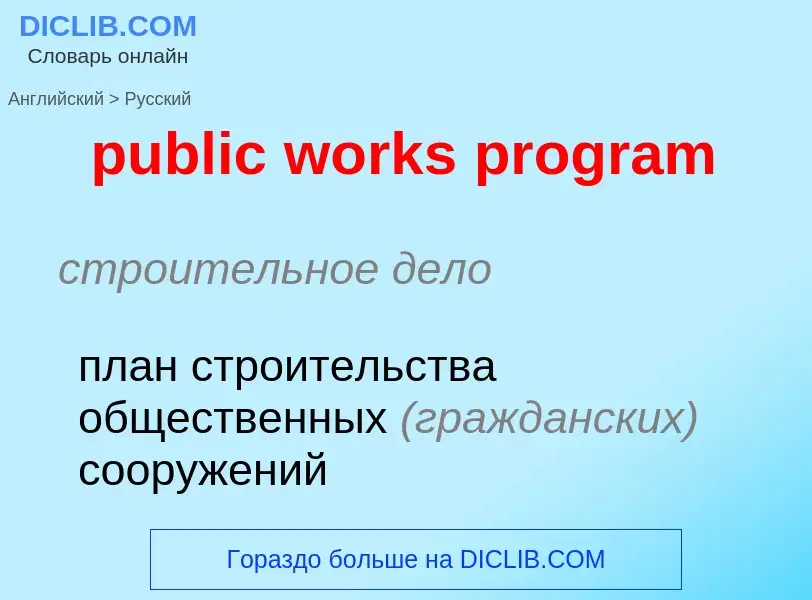Перевод и анализ слов искусственным интеллектом ChatGPT
На этой странице Вы можете получить подробный анализ слова или словосочетания, произведенный с помощью лучшей на сегодняшний день технологии искусственного интеллекта:
- как употребляется слово
- частота употребления
- используется оно чаще в устной или письменной речи
- варианты перевода слова
- примеры употребления (несколько фраз с переводом)
- этимология
public works program - перевод на русский
строительное дело
план строительства общественных (гражданских) сооружений
Википедия

The Public Works of Art Project (PWAP) was a New Deal work-relief program that employed professional artists to create sculptures, paintings, crafts and design for public buildings and parks during the Great Depression in the United States. The program operated from December 8, 1933, to May 20, 1934, administered by Edward Bruce under the United States Treasury Department, with funding from the Federal Emergency Relief Administration.
Although the program lasted less than one year, it had employed 3,749 artists, who produced 15,663 works of art. In an art exhibition that featured 451 paintings commissioned by the PWAP, 30 percent of the artists featured were in their twenties, and 25 percent were first-generation immigrants. The PWAP served as way to employ artists, while having competent representatives of the profession create work for display work in a public setting. According to one news report at the PWAP show at MoMA, "The artists selected for the program were chosen on the basis of their artistic qualifications and their need of employment. The subject assigned to them was the American scene in all its phases."




![[[Earle Richardson]], ''Employment of Negroes in Agriculture'' [[Earle Richardson]], ''Employment of Negroes in Agriculture''](https://commons.wikimedia.org/wiki/Special:FilePath/Earle Richardson, Employment of Negroes in Agriculture, 1934, oil on canvas, Smithsonian American Art Museum 02.jpg?width=200)
.jpg?width=200)

![Edward Bruce]], [[Eleanor Roosevelt]], Assistant Secretary of the Treasury [[L. W. Robert Jr.]], and Forbes Watson look at a map of PWAP's 16 regional districts after the project was announced in December 1933. Edward Bruce]], [[Eleanor Roosevelt]], Assistant Secretary of the Treasury [[L. W. Robert Jr.]], and Forbes Watson look at a map of PWAP's 16 regional districts after the project was announced in December 1933.](https://commons.wikimedia.org/wiki/Special:FilePath/Public Works of Art Project Leaders.jpg?width=200)

![Kenneth M. Adams]], ''Juan Duran'' (New Mexico) Kenneth M. Adams]], ''Juan Duran'' (New Mexico)](https://commons.wikimedia.org/wiki/Special:FilePath/Juan Duran SAAM-1964.1.148 1.jpg?width=200)
![[[Dewey Albinson]], ''Northern Minnesota'' (Minnesota) [[Dewey Albinson]], ''Northern Minnesota'' (Minnesota)](https://commons.wikimedia.org/wiki/Special:FilePath/Northern Minnesota Mine SAAM-1964.1.49 1.jpg?width=200)
![[[Ivan Albright]], ''The Farmer’s Kitchen'' (Illinois) [[Ivan Albright]], ''The Farmer’s Kitchen'' (Illinois)](https://commons.wikimedia.org/wiki/Special:FilePath/Ivan Albright, The Farmer's Kitchen, ca. 1934, oil on canvas, Smithsonian American Art Museum, Transfer from the U.S. Department of Labor, 1964.1.74.jpg?width=200)
![Laverne Nelson Black]], ''Jicarilla Apache Fiesta'' (New Mexico) Laverne Nelson Black]], ''Jicarilla Apache Fiesta'' (New Mexico)](https://commons.wikimedia.org/wiki/Special:FilePath/Jicarilla Apache Fiesta SAAM-1985.7 1.jpg?width=200)
![[[Norman S. Chamberlain]], ''Corn Dance, Taos Pueblo'' (California) [[Norman S. Chamberlain]], ''Corn Dance, Taos Pueblo'' (California)](https://commons.wikimedia.org/wiki/Special:FilePath/Corn Dance, Taos Pueblo SAAM-1964.1.77 1.jpg?width=200)

![[[Ross Dickinson]], ''Valley Farms'' (California) [[Ross Dickinson]], ''Valley Farms'' (California)](https://commons.wikimedia.org/wiki/Special:FilePath/Valley Farms SAAM-1964.1.40 1.jpg?width=200)
![[[Arthur Durston]], ''Industry'' (California) [[Arthur Durston]], ''Industry'' (California)](https://commons.wikimedia.org/wiki/Special:FilePath/Industry SAAM-1964.1.92 1.jpg?width=200)
![[[Claire Falkenstein]], ''Inside a Lumber Mill'' (California) [[Claire Falkenstein]], ''Inside a Lumber Mill'' (California)](https://commons.wikimedia.org/wiki/Special:FilePath/Inside a Lumber Mill SAAM-1964.1.158 1.jpg?width=200)
![Gerald Sargent Foster]], ''Racing'' (New Jersey) Gerald Sargent Foster]], ''Racing'' (New Jersey)](https://commons.wikimedia.org/wiki/Special:FilePath/Racing SAAM-1965.18.9 1.jpg?width=200)

![[[Lily Furedi]], ''Subway'' (New York) [[Lily Furedi]], ''Subway'' (New York)](https://commons.wikimedia.org/wiki/Special:FilePath/Subway, Furedi, 1934.jpg?width=200)

![[[Z. Vanessa Helder]], ''Alki Point Lighthouse'' (Washington) [[Z. Vanessa Helder]], ''Alki Point Lighthouse'' (Washington)](https://commons.wikimedia.org/wiki/Special:FilePath/Alki Point Lighthouse SAAM-1974.28.154 1.jpg?width=200)

![[[Louis Hirshman]], ''The Factory'' (Pennsylvania) [[Louis Hirshman]], ''The Factory'' (Pennsylvania)](https://commons.wikimedia.org/wiki/Special:FilePath/Factory SAAM-1964.1.185 2.jpg?width=200)


![[[Ila Mae McAfee]], ''Mountain Lions'' (New Mexico) [[Ila Mae McAfee]], ''Mountain Lions'' (New Mexico)](https://commons.wikimedia.org/wiki/Special:FilePath/Mountain Lions SAAM-1964.1.80 1.jpg?width=200)
![[[Frank Mechau]], ''Horses at Night'' (Colorado) [[Frank Mechau]], ''Horses at Night'' (Colorado)](https://commons.wikimedia.org/wiki/Special:FilePath/Horses at Night, Frank Mechau.jpg?width=200)
![[[Abram Molarsky]], ''The Storm'' (New Jersey) [[Abram Molarsky]], ''The Storm'' (New Jersey)](https://commons.wikimedia.org/wiki/Special:FilePath/Storm SAAM-1966.31.14 1.jpg?width=200)


![[[William S. Schwartz]], ''Americana (No. 2)'' (Illinois) [[William S. Schwartz]], ''Americana (No. 2)'' (Illinois)](https://commons.wikimedia.org/wiki/Special:FilePath/Americana (No. 2) SAAM-1964.1.23 1.jpg?width=200)



![[[Santos Zingale]], ''Lynch Law'' (Wisconsin) [[Santos Zingale]], ''Lynch Law'' (Wisconsin)](https://commons.wikimedia.org/wiki/Special:FilePath/Santos Zingale Lynch Law 1934 oil on canvas UWM Art Collection Gift of the Works Progress Administration.jpg?width=200)

